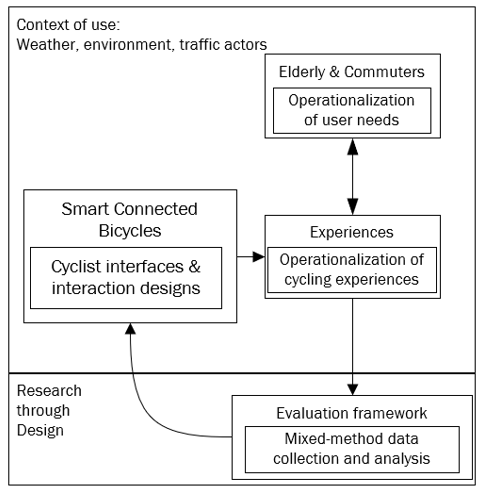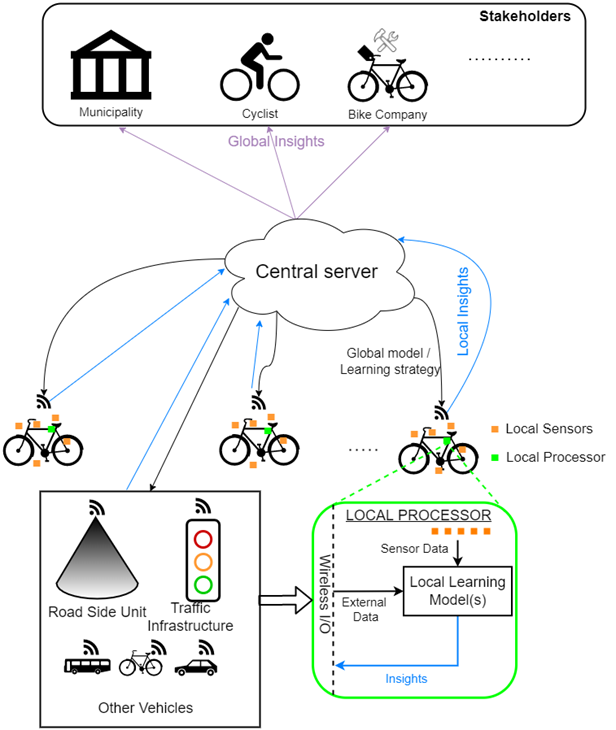Georgios Kapousizis’s proposal:
The use of e-bikes is associated with a reduction in motorized vehicle use, which has potential positive impacts on the environment and health. Furthermore, it is well recognized the bike's usefulness as it improves users' well-being. E-bikes are rapidly gaining popularity in the Netherlands since, in 2020, a record-high number of e-bikes (over 420,000) were sold. Also, in the Netherlands, in 2019, around 18% of bicycle trips were made by e-bike users, which roughly translates to one-fifth of the total, and an increase in the number of injuries among e-bike users has been observed. Considering the constantly evolving landscape of electric bike adoption, the questions of what level of new technologies apply to bikes and how such technologies will be perceived by bike consumers/users are still under scrutiny.
The aim of this research project is to evaluate the impacts of smart connected bikes (SCB) prototypes on traffic safety and user’s acceptance level. A SCB is an e-bike is connected with urban infrastructure as well as to other vehicles through wireless technologies.
We target to address the following four research questions (RQs) which are inseparably connected and translate to Scoping, Designing, Developing and lastly, Evaluating phase. Thu, this thesis comprises four parts and corresponding outcomes: first, technologies potentially incorporated on SCBs affecting safety will be studied through a literature review analysis. Second, the user’s acceptance level and willingness to pay of SCBs will be investigated by conducting a survey in nine European countries. Third, a traffic safety model will be created based on existing injury databases (BRON) and other variables across the Netherlands. Finally, in the fourth part, the traffic safety impacts of the SCB prototypes will be examined through field trails.
To sum up, this thesis examines the traffic safety impacts of the SCBs, and the user’s acceptance and willingness to pay for new systems (e.g., intervention, speed adaptation). In addition, aims to investigate the effects of cyclists’ riding behaviour and perceived safety.
The outcome from each part of this research project will lead to four academic publications (peer-reviewed articles)and be used as input to other PhD students who collaborate with the smart connected project in order to develop the smart connected ecosystem in a better way.

---------------------------------------------------------------------------------------------------------------------------------------------
Mario Boot’s proposal:
The primary aim for this PhD project is to develop a validated framework for evaluating effects of prototypes for Smart Connected Bicycles (hereafter: SCBs) on elderly and commuter cycling experiences. In SCBs, interfaces and interaction design (hereafter: SCB systems) between the bicycle, the cyclist, the environment, and other traffic actors provide stimuli which impact the subjective and internal responses that cyclists experience while cycling. New SCB systems such as wayfinding apps and speed adaptation systems can for example trigger emotions, cause distraction, reduce comfort, and increase perceived traffic safety. Two knowledge gaps with respect to experiences with SCBs are addressed. Firstly, an integrated set of data collection and data analysis methods to evaluate the impact of SCB systems on cycling experiences is missing. Existing methods overly focus on instrumental aspects of transport, and do not include innovative sensors for capturing experiences. Secondly, validated knowledge about how SCB systems are impacting cycling experiences is missing. The primary aim is divided into four sub-aims: 1) acquire knowledge about state of the art methods for measuring and analysing cycling experiences, and conceptualize an evaluation framework; 2) realize a validated sensor system that can capture cycling experiences; 3) integrate experience sensors, camera footage, surveys, interviews, and ride-alongs into a low-burden and mixed method data collection approach; and 4) use a data analysis method for the purpose of building knowledge about causality and correlation between SCB systems, collected data, and perceived experiences. Research methods are a literature review, iterative design research, data collection in field trials, and quantitative data analysis. Together, these aims and methods will result in four peer-reviewed journal papers.

---------------------------------------------------------------------------------------------------------------------------------------------
Deepak Yeleshetty’s proposal:
Collaborative Intelligence & Secure Data Sharing in Smart Connected Bikes
Data is pervasive in diverse forms and from diverse sources. Today’s world thrives on data analytics in multiple disciplines. In the Smart Connected Bikes project, we aim to incorporate data analytics in bicycles by gaining cycling-related insights from multiple data sources that benefits stakeholders involved. The cooperation of smaller vehicles such as bikes with the other road vehicles, will not only improve cycling, but the overall road mobility [1].
Apart from the practical constraints like size and resources, potential “smart” bikes also pose data-related problems such as data heterogeneity, security, and privacy/ confidentiality. We aim to tackle the data-related problems by building a single model that extracts multiple insights from multiple data sources. The data sources could be the local sensors or external sources (from the infrastructure, other vehicles, etc.). Such a system’s dataflow is illustrated in Figure 1. We will explore and use access control methods, Federated Learning and Multi-Party Computation to maintain data security, privacy, and confidentiality.
The insights we plan on gaining are: Road Quality, Traffic Flow, and Cycling Speed. Each of these insights are expected to benefit one or more of the stakeholders: Municipality, Cyclist, and Bike company. Initial field-trials will be carried out in the city of Enschede to monitor the cycling road condition. A fusion of sensors such as Inertial Measurement Unit, GPS, Bluetooth, etc. will be used to acquire bicycle data. Going forward, we will analyze the sensor-data and quantify the road condition, while also adding other modalities to gain more insights.
References
[1] R. Sanchez-Iborra, L. Bernal-Escobedo, and J. Santa, “Eco-Efficient Mobility in Smart City Scenarios,” Sustain. 2020, Vol. 12, Page 8443, vol. 12, no. 20, p. 8443, Oct. 2020, doi: 10.3390/SU12208443.

Figure 1: The ecosystem of Smart Connected Bikes
---------------------------------------------------------------------------------------------------------------------------------------------
Khalil Ben Fredj’s proposal:
B2X wireless communication for smart bikes
Since the last decade, vehicular networks have emerged to support different applications varying from safety to traffic efficiency and infotainment. Throughout this PhD research and in collaboration with the smart connected bikes project, we are aiming to enable wireless communication for bicycles in order to permit the bidirectional exchange of information with other road users and the infrastructure.
The continuously changing network topology, network disconnection, and highly dense and sparse networks represent the main challenges. In this project, we aim to explore novel technologies such as Reinforcement Learning, and edge Computing combined with medium access control schemes and routing techniques to meet the various application requirements. In this stage, delay-tolerant and non-delay-tolerant services will also be investigated.
By defining some use case scenarios, we will also be implementing our solutions and conducting field tests and trials in the city of Enschede to evaluate the performance of the designed communication system.